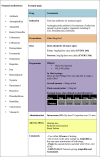Staged implementation of a two-tiered hospital-based neonatal care package in a resource-limited setting in Eastern Uganda
- PMID: 29527347
- PMCID: PMC5841522
- DOI: 10.1136/bmjgh-2017-000586
Staged implementation of a two-tiered hospital-based neonatal care package in a resource-limited setting in Eastern Uganda
Abstract
Neonatal mortality remains a major global challenge. Most neonatal deaths occur in low-income countries, but it is estimated that over two-thirds of these deaths could be prevented if achievable interventions are scaled up. To date, initiatives have focused on community and obstetric interventions, and there has been limited simultaneous drive to improve neonatal care in the health facilities where the sick neonates are being referred. Few data exist on the process of implementing of neonatal care packages and their impact. Evidence-based guidelines for neonatal care in health facilities in low-resource settings and direction on how to achieve these standards of neonatal care are therefore urgently needed. We used the WHO-Recommended Quality of Care Framework to build a strategy for quality improvement of neonatal care in a busy government hospital in Eastern Uganda. Twelve key interventions were designed to improve infrastructure, equipment, protocols and training to provide two levels of neonatal care. We implemented this low-cost, hospital-based neonatal care package over an 18-month period. This data-driven analysis paper illustrates how simple changes in practice, provision of basic equipment and protocols, ongoing training and dedicated neonatal staff can reduce neonatal mortality substantially even without specialist equipment. Neonatal mortality decreased from 48% to 40% (P=0.25) after level 1 care was implemented and dropped further to 21% (P<0.01) with level 2 care. In our experience, a dramatic impact on neonatal mortality can be made through modest and cost-effective interventions. We recommend that stakeholders seeking to improve neonatal care in low-resource settings adopt a similar approach.
Keywords: Africa; low resource setting; neonatal care; neonatal unit.
Conflict of interest statement
Competing interests: None declared.
Figures






References
Publication types
LinkOut - more resources
Full Text Sources
Other Literature Sources
